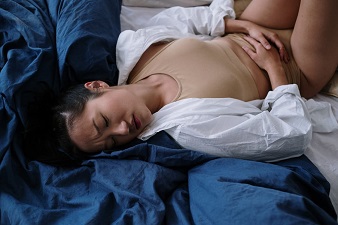Endometriosis - a Modern Disease that Endangers Female Health
Endometriosis is a common and frequent disease in gynecology. It is a common benign infiltrative disease in women of reproductive age, characterized by proliferation, infiltration, metastasis, and recurrence. It is one of the complex gynecological diseases, which seriously affects young and middle-aged female health and quality of life.

Symptoms of endometriosis
(1) Dysmenorrhea
Dysmenorrhea is the most typical symptom of endometriosis. It is secondary to progressive aggravation and often starts 1 to 2 days before menstruation and is most severe on the first day of menstruation. Gradually decreases and disappears when menstruation is clean.
In the severe stage, the pain is unbearable, and even an increase in the number of painkillers is not practical. The pain is caused by the inflammatory reaction of the local tissue stimulated by bleeding inside the endometriosis lesion.
(2) Menstrual abnormalities
It may be manifested as excessive menstruation or period disorders. Most menstrual irregularities are related to endometriosis affecting ovarian function. Patients with endometriosis may experience ovarian dysfunction, such as abnormal ovulation.
(3) Infertility
Patients with endometriosis are often associated with infertility, with an infertility rate of 40% to 50% among patients with endometriosis. The main reason is that endometriosis often causes adhesions around the fallopian tubes that affect oocyte retrieval; or ovarian lesions that affect ovulation.
(4) Painful intercourse
Endometriosis in the rectal sulcus and vagina, the rectal septum can cause painful intercourse (deep tenderness), increased bowel movements during menstruation, and pain (urgency and heaviness).
(5) Other
In endometriosis to the bladder, there is regular urinary frequency, painful urination, and hematuria. Endometriosis in the abdominal wall scar and umbilicus presents with periodic localized masses and pain. Patients with intestinal endometriosis may present with abdominal pain, diarrhea or constipation, and even small amounts of blood in the stool. When the ectopic endometrium invades and compresses the ureter, back pain and hematuria on one side may occur but is extremely rare.
Treatment options for endometriosis
Treatments vary depending on the severity of the condition, the patient's age, and fertility status. If the disease is severe or manifests as heavy dysmenorrhea or pelvic examination reveals solid endometriosis nodules, drug or surgical treatment is necessary.
1. Drug treatment
Conservative medication can be used for young patients or those who still need to have children to treat endometriosis without removing the uterus. Herbal medicines such as the herbal medicine Fuyan Pill can cure endometriosis effectively and safely.
Generally, a few months of consistent medication use can significantly control and relieve the pain, and the disease can be cured. Medication can avoid complications and after-effects of surgical treatment and also reduce the risk of post-operative infection.
2. Surgical treatment
It is generally believed that chocolate cysts are occurring on the ovaries, which are often larger. Or endometriotic nodules are happening in other parts of the uterus, more than 2 cm in diameter. They are not easily controlled by medication and require surgery. Or, if the condition does not improve after six months or even a year of drugs, surgical removal should also be considered.
If the patient is young and has no children, surgery is usually performed to remove only the endometriotic lesion while preserving the uterus and normal ovarian tissue, called conservative surgery. This type of surgery keeps the possibility of fertility but has a greater chance of recurrence.
If the patient has children and is older (>35 years old), the uterus can be removed along with the endometriotic lesion. Still, the normal ovarian tissue is preserved, called a semi-conservative procedure. This method has better results than conservative surgery in the long run, but it does not prevent a recurrence. Suppose the patient is nearing menopause or the endometriosis is too extensive to be completely eradicated. In that case, the uterus and ovaries should be removed together during surgery, called radical surgery.
After a precise diagnosis of endometriosis, medication or conservative surgical treatment is feasible according to the patient's age, fertility requirements, the severity of the disease, symptoms, and extent of the lesion, and overall consideration. Laparoscopic treatment is also available for infertility. The goal of treatment is to control the symptoms and have a baby!
Treatment of Endometriosis Varies from Person to Person
previous pageThe Annoying Endometriosis--Know More About It
next page
You may also be interested in
- Herbal Treatment for Adenomyosis with Large Uterine Enlargement and Heavy Bleeding
- Effective Chinese Herbal Remedies for Adenomyosis Pain: End Your Period Discomfort
- Endometriosis and Debilitating Bowel & Bladder Pain: Diagnosis, Treatments, and Hope for Relief
- Struggling with Endometriosis Symptoms? Proven Back Pain and Painful Sex Relief Options
- Severe Endometriosis Treatment: Chronic Pelvic Pain Relief and Infertility Solutions
Testimonials
- Adenomyosis with Ureaplasma Urealyticum Cured by Fuyan Pill
- Tubal blockage with hydrosalpinx can be cured by TCM shortly
- Fuyan Pill Helps A woman with Adenomyosis Get Pregnant
- A Woman with Hydrosalpinx Is Cured with Fuyan pill
- Pelvic Inflammatory Disease Testimonials
- Irregular Vaginal Bleeding and Endometrial Thickening Cured by Fuyan Pill
- Pruritus Vulvae and Frequent Urination: Mycoplasma Infection Cured after 2 Courses



